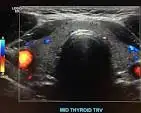How to Interpret Thyroid Ultrasound: 3 Essential Methods
Thyroid ultrasound is a crucial imaging technique for assessing the thyroid gland, a small butterfly-shaped gland located at the base of your neck. This guide will help you understand what a thyroid ultrasound can show, why it’s used, and how to interpret its results.
What is a Thyroid Ultrasound?
A thyroid ultrasound uses sound waves to create real-time images of the thyroid gland, making it a safe and non-invasive way to evaluate thyroid health. Let’s explore the key findings and why this technique is important.

What Can a Thyroid Ultrasound Show?
- Nodule Detection: Identifies thyroid nodules, their size, shape, and characteristics.
- Cyst Evaluation: Detects and assesses thyroid cysts, determining if they are fluid-filled or solid.
- Gland Size and Shape: Assesses the overall size and shape of the thyroid gland, checking for enlargement (goiter).
- Blood Flow: Can visualize blood flow within the thyroid gland and nodules.
- Guidance for Biopsy: Used to guide fine-needle aspiration biopsies of suspicious nodules.
Why Might You Need a Thyroid Ultrasound?
- Palpable Nodules: When a nodule is felt during a physical examination of the neck.
- Abnormal Blood Tests: When thyroid hormone levels (TSH, T3, T4) are abnormal.
- Suspected Goiter: To examine an enlarged thyroid gland.
- Follow-up Imaging: To monitor the progress of known thyroid nodules or conditions.
- Neck Pain or Swelling: To determine the cause of discomfort in the neck.
How is a Thyroid Ultrasound Performed?
A thyroid ultrasound is a straightforward and painless procedure, typically performed in a doctor's office or imaging center. Here's what you can expect during the process:
Preparation
- No Special Prep: Usually, no specific preparation is needed. You can eat and drink normally before the scan.
- Clothing: Wear comfortable clothing that allows easy access to your neck. You may be asked to remove any necklaces or jewelry.
Procedure Steps
- Positioning: You'll lie on your back with your neck slightly extended. A pillow or cushion might be placed under your shoulders.
- Gel Application: A clear, water-based gel is applied to the skin over your neck. This gel helps the transducer (probe) make better contact with your skin.
- Transducer Movement: The sonographer will gently move the transducer over your neck, capturing real-time images of your thyroid gland.
- Image Acquisition: The ultrasound machine will display the images on a monitor, and the sonographer may take several measurements.
- Duration: The procedure typically takes about 15 to 30 minutes.
- Clean Up: The gel is wiped off after the procedure, and you can resume your normal activities.

What to Expect
- Painless: The procedure is painless and non-invasive.
- Comfortable: You may feel slight pressure as the transducer moves across your neck.
- Real-time: The sonographer can view the thyroid gland in real-time, which allows for precise evaluation.
How to Interpret Thyroid Ultrasound Results
Understanding your thyroid ultrasound results is crucial for proper healthcare management. Here’s an overview of methods you can use to get help interpreting them.
1. Utilizing X-ray Interpreter
X-ray Interpreter offers AI-driven analysis of ultrasound images, including thyroid scans:
- Registration: Sign up on X-ray Interpreter to access our AI analysis tool.
- Uploading Ultrasounds: Upload your thyroid ultrasound images for analysis.
- Reviewing Interpretation: Receive an AI-generated interpretation and comprehensive report.
- Consultation: Always seek advice from your healthcare provider for complete diagnosis.
Check our get started guide for more details.
2. Using ChatGPT Plus
ChatGPT Plus, with its GPT-4V model, can provide assistance in analyzing ultrasound images:
- Subscription: Subscribe to ChatGPT Plus for advanced analysis features.
- Uploading Ultrasounds: Upload your thyroid ultrasound images to the OpenAI platform.
- Request Analysis: Ask the AI to interpret your images and provide a report.
- Review and Validate: Review the results with a healthcare professional for accuracy.
Learn more in our blog about using ChatGPT Plus for medical image interpretation.
Alternatively, as several other AI models with vision capabilities emerge, you can also try other models, such as Grok by xAI, Claude by Anthropic, Gemini by Google Deepmind.
3. Understanding the Basics Yourself
While it’s essential to consult with medical professionals, gaining a basic understanding can empower you during consultations.
- Learn Basic Thyroid Anatomy: Understand the structure and location of the thyroid.
- Read Informative Guides: Use online resources to understand common findings in ultrasounds.
- Prepare Questions: Note any unfamiliar terms or findings and ask your doctor for clarification.
- Consult Experts: Always validate your understanding with a medical professional.
Comparing the Different Approaches
Here’s a comparison of the different methods for interpreting thyroid ultrasounds:
| Criteria | X-ray Interpreter | ChatGPT Plus | Self-Reading |
|---|---|---|---|
| Accuracy | High (AI-based)1 | High (AI-based)1 | Varies (Skill-dependent) |
| Ease of Use | Easy | Moderate | Challenging |
| Cost | Starting from $2.50 per image | $20 per month | Free (excluding educational costs) |
| Time Efficiency | Fast | Moderate to Fast | Slow to Moderate |
| Learning Curve | Low | Low to Moderate | High |
| Additional Resources | Provided | Partially Provided (through OpenAI) | Self-sourced |
Each method provides unique advantages, with AI options offering fast and detailed analyses, while basic understanding helps in better patient-doctor communication.
Conclusion
Thyroid ultrasounds are a vital diagnostic tool for assessing thyroid health. This guide has introduced you to the utility of the procedure and the different methods available to understand the results, including self-guided research, AI tools and expert validation.
When deciding on a method, consider your specific needs, understanding levels, and access to resources. Always prioritize privacy standards and seek expert medical validation.